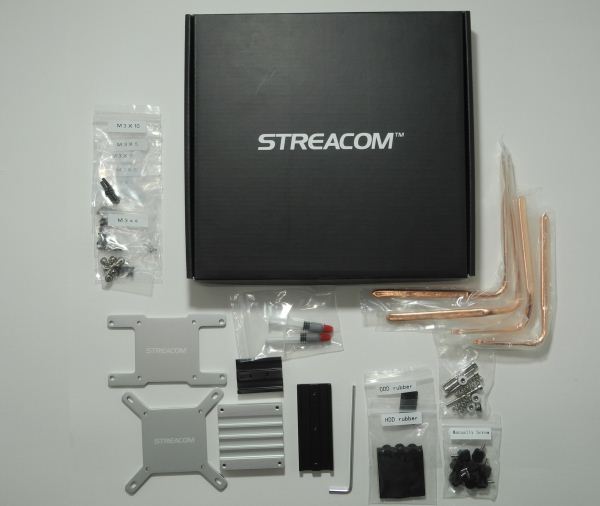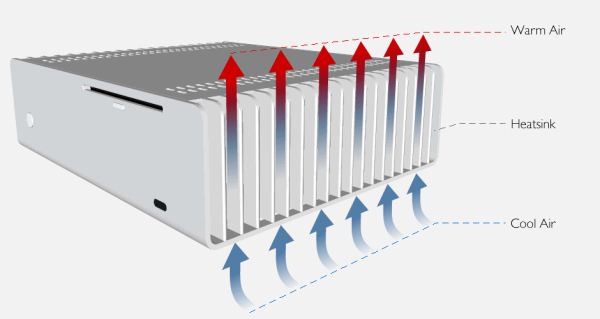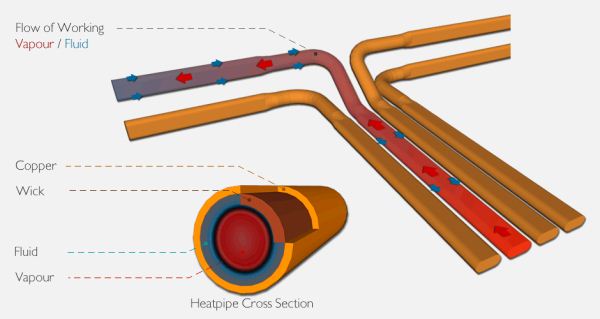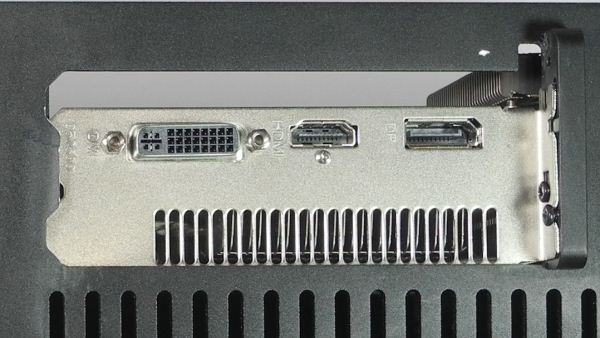Streacom's FC10 and Nano150: Building a Fanless Ivy Bridge HTPC
by Ganesh T S on December 22, 2012 3:30 AM EST- Posted in
- HTPC
- Fanless
- Ivy Bridge
Passive Build Chassis & PSU
Streacom FC10 Premium HTPC ATX Chassis:
The FC10 comes in a plain, but, easy to carry around package. The sophisticated appearance of the package belies the fact that it just contains a computer case. The internals of the package are neatly laid out, with the heat conduction plates, pipes and other miscellaneous components in one box and a detailed assembly manual on top of it.
Describing the chassis itself as a thing of beauty would be an understatement. Our sample unit came in black (silver is also available). The chassis is made of solid aluminium and has a sandblasted finish lending it a premium look. After taking a look at the case, I can say that Streacom isn't exaggerating when they claim that the FC10 is a 'work of art combining form and function'.
The hard drive bays support up to 2 x 3.5" and 3 x 2.5" drives. There is also a slim slot loading optical drive slot. There are two USB ports on the side. We also have the option to add an IR receiver to the system. The unit also has a slot to place one of the Streacom PSUs which come in 150, 180 and 250W varieties. The chassis measures 435 x 319 x 100mm and weighs 5.4 Kgs.
The FC10 chassis cooling solution support both AMD and Intel CPUs.
The cooling solution consists of two components, the fins on the chassis and the heat pipes to take the heat away from the processor surface.
The chassis fins contribute to the cooling through convection by natural airflow. The heat pipes contribute through cooling by phase change, i.e, liquid water in the heat pipes close to the processor evaporates and moves towards the chassis fins where it condenses and gets transported back closer to the processor.
Inside the chassis, we have plenty of space and even two PCIe slots. The PCIe cards have to be mounted with flexible risers. Unfortunately, here is where we encountered our first issue with the FC10. Streacom went in for non-standard spacing between the two PCIe slots. This rules out the usage of dual-slot cards in the system. Streacom came back to us with the reasoning that having the 2 slots at the normal width would have left the dividing strip too thin and weak because of the all-aluminium chassis.
Dual Slot GPU Compatibility
One of our reasons for going with the FC10 fanless chassis was to use it as a HTPC GPU testbed too. I have long since held the view that any HTPC GPU worth its salt had to come in a passive version from at least one AIB vendor. In 2012, we are at a stage where the integrated GPUs in Trinity and Ivy Bridge are more than enough for average HTPC users.
In order for users to get any meaningful HTPC capability not provided by Trinity and Ivy Bridge, a moderately powerful GPU such as the AMD 7750 or the NVIDIA GT 640 is needed. Unfortunately, their passive versions come in dual slot varieties. Not ones to be deterred by the original chassis design, we set out to fix this 'issue' (even though it is a non-issue for the majority of the builders out there). With the help of a rotary tool, it was trivial to take out the offending metal strip and polish and buff the edges. We had a little bit of trouble aligning the second fin inside the chassis, but carefully screwing in the metal plate ensured that the GPU was mounted in a stable manner.
We will be looking at this configuration in detail in the third part of the series, but it should suffice to mention here that the arrangement worked fine in operation throughout. Another minor issue is the range of PSU ratings available. Users going in for a ATX board are not going to be happy with the maximum available 250 W PSU. Streacom indicated that ATX compatibility was mentioned only because the size of the chassis allowed it. However, they expect end-users to use either mITX or uATX motherboards only.
Nano150 Fanless PSU
The Nano150 fanless PSU consists of two major components, the power brick AC / DC adapter and the power delivery module which slots inside the chassis. The power brick output is rated for 12.5A at 12V and operates in the 100 - 240V / 50 - 60Hz range. The bundled power plug was of the EU variety. It isn't much of an issue as the power plug is detachable. In any case, travel adapters are quite cheap. An alternate power cable is probably the better way to go about it if you are not in the EU. In any case, local resellers are bound to include the correct power plug.
The power brick hooks up to the power delivery module through a hole in the chassis. The module plugs directly into the 24-pin ATX power connected on the motherboard. The add-on cable set plugging into the module includes a 4-pin power connector, a molex connector and two SATA power connectors.




























63 Comments
View All Comments
brakteat - Saturday, December 22, 2012 - link
LauRoman is right. Last year I built four fanless computers for our office, using HD-Plex H3.S chassis. Since then they run fast (Core i3-2105+SSD), completely silently (no moving parts) and still very cool (under load, all components are usually below 55 C). Also, after one year there is no visible dust inside the chassis so there is no need for physical maintenance.Of course, if you want to play games at high resolution then HD 4000 is certainly not enough (and my HD 3000 even less so). I always play my games at 2560x1600 and built myself an inaudible gaming computer in a Coolermaster HAF-X. This works great thanks to seven large fans running at low speed. The graphics card is ony cooled by a 200 mm fan. The fans do collect a lot of dust though, even if the case has dust filters. Without maintenance the dust would eventually stop the computer from working.
EnzoFX - Saturday, December 22, 2012 - link
TRUE. The single best reason to go for passive is no dust. Can't argue against someone wanting zero maintenance.Death666Angel - Saturday, December 22, 2012 - link
I have an HTPC with one fan that serves double duty as the cpu heatsink fan and the case fan (I cut a large hole above into the case above the heatsink so the fan could get fresh air), I also have a dust cover just above it that works with magnets. Every time my wife or I vacuum the living room, we just take it off, vacuum it as well and put it back on. nearly zero maintenance and much more powerful if I wanted to. Also, silent in the current setup. I would never go with a fanless case.But I do see that for some people/situations, adding fans does not bring anything to the table because they just don't need the power or cooler running components. :)
EnzoFX - Saturday, December 22, 2012 - link
Yes exactly. Some people really want zero maintenance, and aren't going to be gaming on it =P. I myself am drawn to such a setup, but I've never been able to commit, and probably never will. So it does go to show that it's impractical for more hands-on users, seeing as with just a little work, you get much more in return.colonelciller - Sunday, December 23, 2012 - link
this case is perfect for playing 1080 P video streamed from a home media server (in another room).looks like a ZERO compromise machine to people who want silence.
For those who want a do-it-all noise maker next to there TV there are other cases.
ryccoh - Saturday, December 22, 2012 - link
Check out Silverstone cases. They like to mount two slow 180mm fans on the buttom blowing air out the top of the case with the motherboard turned 90 degrees.colonelciller - Sunday, December 23, 2012 - link
No no no absolutely NOTThe whole point of this case is silence with a capital 'S'.
The case is perfect as is. Even the quietest fans are not silent which is a complete FAIL for those seeking true Silence from the HTPC.
Couple this case with an efficient cpu with integrated graphics and a small SSD for OS only and you've got perfection.
Store all your media on a home server where it belongs. As soon as you try to turn a HTPC into a do-it-all machine you start making compromises.
CaioRearte - Saturday, December 22, 2012 - link
Hello, please evaluate how this build would turn out powered by one of AMD Trinity's APUs. They have 65W parts that can be passively-cooled and it might be interesting to see how the IGP performs, especially since Intel's integrated graphics don't perform at all.kyuu - Saturday, December 22, 2012 - link
+1random2 - Saturday, December 22, 2012 - link
Yes, but the i3-3225 sure performs. The integrated graphics on these APUs get their butts handed to them on a platter by the lowly 640 GPU used here. Added to that is the fact that CPUs do make a difference in times for individual frame rendering and in game frame rates.http://techreport.com/review/23246/inside-the-seco...